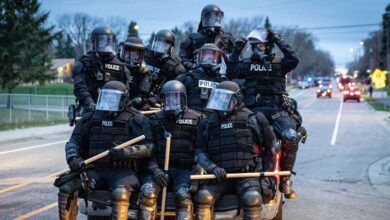‘One Minnesota’ budget could impact Black communities


With a revision of the state’s budget proposal being unveiled, members of the Walz administration have underlined their commitment to equity in helping craft the proposal by engaging Black and Brown Minnesotans every step of the way.
Last Thursday, Governor Tim Walz and Lieutenant Governor Peggy Flanagan shared their revised “One Minnesota” budget proposal after releasing a previous version earlier this year. The new proposal includes new investments in the areas of public safety, education, and local projects.
According to Governor Walz, the fundamentals of the proposal haven’t changed, but new information gained in that time helped the administration restructure its budget to have the capacity to invest in more areas—most notably in public safety where there is an increase of over $200 million dollars.
The administration’s One Minnesota budget aims to invest in several areas such as childcare, clean energy jobs, and increasing access to comprehensive healthcare. With the state’s surplus topping $17 billion, this budget has provided an opportunity for political leaders to showcase their priorities, by influencing where resources are allocated.
Outreach to communities of color
– ADVERTISEMENT –
To engage marginalized community members and provide them with an opportunity to impact the budget proposal, Dr. Stephanie Burrage, deputy commissioner at the Minnesota Department of Education, formed the “Mind, Body, and Soul” group in the spring of 2022. Through the group, she developed a relationship with leaders and stakeholders within the Black community to provide a platform for discussion around the budget proposal and what community members would like to see included.
“We want to be able to stand by and say, this is not just the governor’s budget, this is our budget too,” Dr. Burrage said.
The group, made up of mostly Black and Brown community members and leaders, met virtually usually once a month, to give direct input and feedback to administrative leaders in Minnesota’s government, including the governor and lieutenant governor. Commissioners or their designees joined the meetings, presenting disaggregated data with the intention of painting a picture of the impact on specific communities.
Dr. Burrage added individuals she believed could speak to the needs of their respective communities and welcomed them to include others who could be beneficial to the process.
The first session started with around 80 people last April but has grown to 800 people. Dr. Burrage says that she sees the group growing to at least 1,000 for their next meeting in April.
– ADVERTISEMENT –
Robert Doty, former commissioner of the Minnesota Department of Revenue and now chief financial officer at the Science Museum of Minnesota is working with Dr. Burrage in virtual budget outreach meetings. Both have worked closely with the Walz administration, so their experience gives them access to the administration in dealing with community members. At times, Governor Walz or Lt. Governor Flanagan or both were present during meetings with Black community members. During these meetings, individuals would share their personal stories and offer solutions to help improve their quality of life.
Commissioners or their delegates would have about 15 to 20 minutes to share information with the community about what their respective agencies were working on and receive feedback from those who would be impacted by their efforts. The sessions also became a great opportunity for individuals to learn more about the legislative process and how the proposal would influence legislation that would then be enforced by agencies.

Mind, Body, and Soul issues
The overarching theme throughout the Mind, Body, and Soul meetings was that this information was being discussed through a lens focused on the experience of Minnesota’s black community.
“We had a rule when we started this. We were not going to use the term BIPOC,” Doty said.
– ADVERTISEMENT –
Flanagan credits this focus on the Black community, the recent passage of the Crown Act and the recognition of Juneteenth as a state holiday, as being due in part to the increased diversity in the legislature.
“It is not an accident that these things are happening when we have three Black women in the Senate,” she said. “All of these things are happening when we have the most diverse legislature and the most Black members that we’ve ever had. The president of the Senate, Bobby Joe Champion is a Black man. That matters.”
Although the focus was on Minnesota’s Black residents, the issues raised were wide and far-reaching. According to Dr. Burrage, workforce development, criminal justice reform, affordable housing, and health were just a few of the issues discussed during these meetings.
There was a particular emphasis on Black wealth-building through homeownership and entrepreneurial support programs.
For small businesses, much of the discussion surrounded proposals to connect Black entrepreneurs to more resources and technical assistance. For homeownership, the focus was on closing the gap between Black and White Minnesotans by supporting first-time homeowners with down payments and access to 0% interest loans.
– ADVERTISEMENT –
“Many households are ready to become homeowners that can afford a mortgage, but they lack sufficient funds for a down payment. The budget includes $28 million over the next two years for down payment assistance and closing costs loans to help homeowners bridge the gap,” Dr. Burrage said.
Economic investment in Black communities
With the recent announcements of businesses exiting the Northside, investment in Black neighborhoods has become crucial for residents and community leaders alike. To address this, Lt. Governor Flanagan pointed to the over $200 million in cash and equity bonding added to the budget proposal as an effort to support organizations led by communities of color that can best disperse these resources to areas and communities that have been historically divested.
The Mind, Body, and Soul group also focused on the topic of education. Lt. Governor Flanagan shared her goal of involving more members of the Black community in the efforts to hire more teachers of color in schools.
“We need to make sure if we have these resources that are available to hire, recruit and retain more Black educators, that we are working with the community themselves to get these folks to apply,” Flanagan said.
As deputy commissioner of the state’s education department, Dr. Burrage was keen on the details surrounding education programs that would support students and their families. She pointed to childcare, culturally specific afterschool programs, and universal meals as initiatives that made it into the budget proposal due to the group’s influence.
While these meetings were mostly productive and informative conversations between administrators and constituents, there were moments when people took time to air their frustrations and hold state leaders accountable.
“Some of the things, quite frankly, that the governor and lieutenant governor are hearing are not always pleasant,” Doty said. “I give them a lot of credit because they sit there, and they listened to the whole thing. They understood the level of passion that’s related to a lot of these specific concerns and ultimately the kind of proposals that came forward from that.”
Flanagan stressed how important it was for her and other political leaders to take the opportunity to listen to constituents directly and embrace their vulnerability. “I think so often what happens when we engage with elected officials or when community engages with elected officials it’s for us to share information,” Flanagan said.
Support Black local news
Help amplify Black voices by donating to the MSR. Your contribution enables critical coverage of issues affecting the community and empowers authentic storytelling.
























































